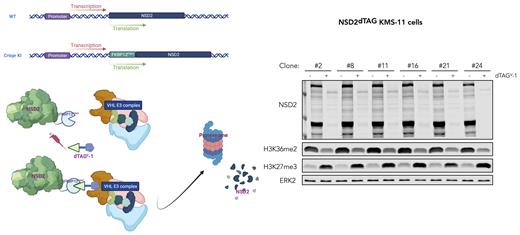INTRODUCTION: NSD2 is a potential therapeutic target in the 15% of cases of multiple myeloma that carry a t(4;14) translocation. As a consequence of the translocation, strong Ig enhancers are placed in proximity to NSD2 and FGFR3. FGFR3 is deleted at a subsequent time point in 25% of cases, while all cases retain NSD2 expression consistent with it likely being the key oncogenic driver. NSD2 is an H3K36 dimethyl transferase, a histone modification mark associated with active transcription, but the molecular targets and the mechanism by which NSD2 regulates its targets is unknown. The cellular function of NSD2 is also largely unknown, but previous shRNA knockdown studies have suggested it is involved in cell proliferation. The major limitation to understanding the role of NSD2 is the lack of an appropriate experimental system with which to investigate its molecular and cellular function. To address this deficit and to identify the primary direct targets of NSD2 as a means to elucidate its mechanism of action we have generated NSD2 dTAG and NSD2 KO cells together with NSD2 reconstitution systems.
METHODS: We have utilized CRISPR gene editing to knock-in a dTAG in NSD2 in the t(4;14) KMS-11 cell line. This system enables the inducible and rapid degradation of NSD2 following the addition of a small-molecule degrader which is otherwise inert. We have also generated clonal NSD2 KO KMS-11 cells that allow us to observe and study the stable phenotypes of NSD2 KO. Because H3K36me2 deposited by NSD2 leads to induction of DNMT3A-mediated DNA methylation and suppression of PRC2-mediated H3K27me3, we have generated DNMT3A KO on top of NSD2dTAG/KO and have used two different PRC2 inhibitors to dissect the dependency of NSD2 function on such secondary modifications.
To systematically dissect the dependency on NSD2 isoforms and its methyltransferase activity, we have reconstituted NSD2 in both NSD2 dTAG and NSD2 KO KMS-11 cells, including WT NSD2I WT, NSD2II WT, NSD2 Y1179A (LOF), NSD2 E1099K (GOF). To maximally match the timing of NSD2 perturbation, NSD2 reconstitution was generated in NSD2 dTAG and NSD2 KO cells in a Tet-ON and Tet-OFF expression system, respectively. Further we have generated KMS-11 cells overexpressing Dox-inducible H3.3K36M to investigate the consequences of abrogation of H3K36me2 by this dominant negative mutant of H3.3. We have done SLAM-seq to assess the transcriptional targets of NSD2 and will extend this with ATAC-seq and CUT&Tag to identify the molecular targets of NSD2.
RESULTS: We show that NSD2 is rapidly degraded within 1 h when a degrader is added and subsequently a significant reduction of H3K36me2 is seen by 24 hours although it takes more than 3 days to see its deep depletion. We observed a reciprocal increase of H3K27me3 as previously noted. Depletion of H3K36me2 and increase in H3K27me3 was also seen in the NSD2 KO KMS-11 cells. Paradoxically we didn't see an induction of apoptosis in response to the degradation of NSD2 or its KO. In sharp contrast to the previously published shRNA results only a mild inhibition of cell proliferation was observed in NSD2 KO cells and over an extended period of 3 weeks in the dTAG system. We didn't observe an effect of H3.3 K36M overexpression on cell proliferation although it abolished H3K36me2 very efficiently. These experiments demonstrate that NSD2 is not essential for viability of KMS-11 cells but is required for optimal cell growth, which is likely independent of its H3K36me2 methyltransferase activity.
SLAMseq results show that NSD2 degradation in the dTAG system causes transcriptional changes of a specific set of newly synthesized mRNAs. ATAC-seq and CUT&Tag experiments are being run and will be superimposed on the SLAM-seq data to identify immediate targets of NSD2. Subsequently, use of PRC2 inhibitors and DNMT3A KO cells in the dTAG cells and the NSD2 reconstitution experiments will uncover the mechanisms of how NSD2 controls the transcription of its targets.
CONCLUSION: We show that NSD2 is not essential for viability of KMS-11 cells but is required for optimal cell growth and that NSD2 controls the transcription of a specific set of genes and does not exert a global impact on the transcriptome. We will further define the immediate targets of NSD2 by leveraging our SLAM-seq, ATAC-seq, and CUT&Tag data in NSD2 dTAG/KO and NSD2-reconstituted cells and by blocking the crosstalk with other epigenetic marks (i.e. H3K27me3 and DNAme).
Disclosures
Davies:Amgen: Membership on an entity's Board of Directors or advisory committees; Regeneron: Membership on an entity's Board of Directors or advisory committees; BMS / Celgene: Membership on an entity's Board of Directors or advisory committees; pfizer: Membership on an entity's Board of Directors or advisory committees; sanofi: Membership on an entity's Board of Directors or advisory committees; Janssen: Membership on an entity's Board of Directors or advisory committees; Takeda: Membership on an entity's Board of Directors or advisory committees.


This feature is available to Subscribers Only
Sign In or Create an Account Close Modal